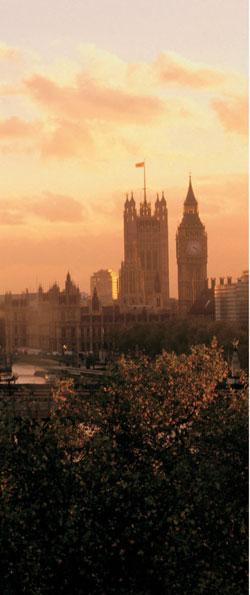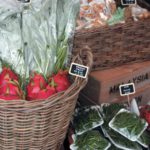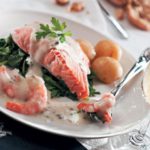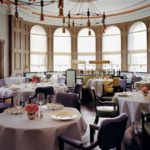Sue de Groot embraces global gastronomy at a British food festival
Sue de Groot
You can tell a lot about a country from its food. If you got into a time machine and were dropped in post-war London, you’d know it immediately from the ration books, the eggless cakes and the way people reacted to the sight of a lemon. With England in the grip of a punishing recession you might expect to find similar privations and belt-tightening measures today. But no. Far from cutting back on luxuries, the capital’s restaurants and purveyors of fine foods seem to have embarked on an orgy of excess, perhaps a psychological antidote to shut-down stores and shaky banks.
Forget about yesterday’s tiny portions of healthy crunchy things: today’s food heroes are rich and heavy. Great slabs of Gloucester pork rub shoulders with panseared patties of foie gras so calorific it’d have you expelled from Weigh Less. Yes foie gras, that controversial piece of French goose anatomy, is back in favour (except perhaps among a few hard-line greenies). Not only is it again common on menus, it so delighted the judges at this year’s Taste of London festival that they named Club Gascon’s foie gras burger the winning dish of the festival, beating Corrigan’s handground steak burger with bone marrow,
The Ritz’s terrine of goose liver, spiced pineapple and gingerbread, and Launceston Place’s spit-roast suckling pig and black truffle roll. And a lot of others. As you can see from theseexamples, low-fat is so last season.
Taste of London opened in June to the sound of popping corks and the splashing of spittle on glossy paper as visitors drooled over the menus. When faced with the best food from 40 of London’s top restaurants (with a grand total of 11 Michelin stars between them), where do you begin?
Held in Regent’s Park every summer, the festival has grown to encompass acres of stands connected by purplecarpeted walkways. Apart from the restaurant stalls – where you can order tasting portions of dishes created by famous chefs – there are multiple distractions in the form of live demonstrations by household names like Gary Rhodes and a dazzling array of fresh produce and polyglot wares from a dozen different countries.
There may well be a logical way to approach this smorgasbord, but I based my plan of attack on where I happened to be standing. The closest restaurant stand was Le Gavroche, so I presented myself at the counter and obtained a beautifully arranged dish called “ballotine of chicken, pickled mushrooms and truffle dressing”. It was delicious. Nearby was Bocca di Lupo, where I requested “three friedballs” – one of olive, veal and pork, one of buffalo mozzarella and one of tomato risotto. They were crispy on the outside and gooey on the inside and possibly the best thing I ate that day.
But it’s hard to tell, because the fried balls were followed by Kent potatoes, delicately spiced Clonakilty white pudding, rich dark rum from Bermuda, ethereal raisin loaf from the famous Bread Shop, a shot of whisky from Wales (yes, Wales – it’s called Penderyn, a single malt and really quite fine), rare beef with triple-cooked chips and béarnaise sauce from a rather snooty attendant at Fino, an intriguing chewy tamarind sweetmeat from Trinidad… and so it went on.
Apart from excess, the Other Big Thing is the provenance of food, something that has been gaining favour in the last decade or so and which has now become almost mandatory on the menus of good restaurants. It’s rare to find anything listed without its family tree alongside, in fact I’m sure soon we’ll see things like “goose born in Cornwall, raised in Devon and transported by lowemission lorry to London”. It is, however, an admirable trend and one which makes us all feel better about what we eat. Even if it’s foie gras.
After so much food from so many places, you will understand that by the time I got to the winning dish, the foie gras burger, I wasn’t exactly what you might call starving. Which might be why I couldn’t do it. I just couldn’t. Sorry, Club Gascon, but it would havebeen a bun too far.
Maybe I should have gone back the next day and started from scratch. But the next day I was sighing under a bridge on the south bank of the Thames. I thought I’d never eat again, but the pies and fruit and fish and vegetables and spices on display at London’s Borough Market (and in particular the cheeses at Neal’s Yard Dairy, pictured below) almost drove me back to Regent’s Park for another go at that goose liver. The market is where you’ll find some of the best London foodand ingredients at any time of year – it’s like a food festival that renews itself every day, six days a week.
Sue de Groot was a guest of British Airways. Taste of London happens every year in June. For special packages keep an eye on the British Airways website www.ba.com.
Dinner at the Langham
Michel Roux Jnr is the genius behind Roux at the Landau, a restaurant housed in one of London’s grandmold hotels, the Langham. With interiors redesigned by architect du jour David Collins, the opulent setting is exactly the right place for a grandiose menu. The meal was memorable not only for the Kent asparagus with Serrano ham and the lemon verbena panna cotta, but for the best roast pork crackling I have ever seen, heard and especially tasted. It was a long strip that extended beyond both sides of my plate by a good few inches: crisp and golden and salty with exactly the right degree of crunch. Roux also makes crème brûlée the proper traditional way, in a wide, shallow plate. No wonder the restaurant is favoured by famous diners. Visit www.rouxatthelandau.com.
Not just pie in the sky
This year Taste of London sponsor British Airways challenged Heston Blumenthal to create the ultimate inflight dish (as seen on the TV show Heston’s Mission Impossible). He and a team of scientists discovered that your ability to taste can be reduced by up to 30 percent at altitude. They experimented with flavour combinations to counteract these effects, and at Taste of London British Airways revealed its “height cuisine” concept. For the new onboard menus Heston recommended ingredients high in umami, the savoury “fifth taste”, which occurs in foods such as seaweed, tomatoes, mackerel and Parmesan. The palate seems to retain its sensitivity to umami while losing other abilities at altitude. Some umami-based dishes available in first class on British Airways include Loch Duart salmon and spiced Berber lamb. Visit www.ba.com.
Lunch at Le Méridien
I’m willing to bet that Michael Dutnall, Chef de Cuisine of Le Méridien hotel in the heart of the West End, will soon be a featured name at Taste of London. The ninestorey hotel has a great big indoor swimming pool, a bar where you can order hot chocolate made with Godiva chocolates, and the airy Terrace Restaurant, with a glass roof and an open veranda overlooking perpetualmotion Piccadilly. Lunch was sublime: beetroot-cured salmon, meltingly tender new-season lamb and a vanilla panna cotta and champagne summer fruits that came in a praline basket you could actually eat without breaking your teeth. Last year Michael won the dessert section in the Trophée Passion, a culinary competition held in Paris, so his perfect praline is no surprise. Visit www.lemeridienpiccadilly.com.
Petrus Madutlela, last year’s Unilever Foodsolutions Senior Chef of the Year, is now Chef de Partie at the River Restaurant at London’s Savoy Hotel. Pete arrived late last year during one of the coldest winters on record: “It was snowing! But I didn’t care.Being in London is a dream come true.” Of course, the capital’s a chilly place in more ways than one. Despite being married to an English woman, Pete was shocked by rush-hour commuters’ casual disregard for one another. “You’ll be on the tube or on a train, and people don’t talk – they just read their newspapers. In South Africa, youcan jump onto a train or a bus and start talking. If an older person is standing up, you’ll let the older one sit and you stand. Here, they don’t care.”
But the Savoy’s new Chef de Partie is settling into London life just fine. His CV reads like a masterclass in how to make your own luck. Eleven years ago he was a kitchen porter at Pecanwood Golf Estate when the head chef saw his potential and gave him a chance to cook. Pete rose quickly through the ranks. He worked at the Airport Sun and Aqua in Durban, then set his sights on Le Quartier Francaise in Franschhoek, rated one of the world’s top 50 restaurants.
“I’d read about the restaurant and wanted to work with Margot Janse,” he says. “I did a day stint, then she called and asked if I wanted to join the team.” Pete credits Margot with teaching him modern methods such as sous-vide, as well as giving him a template for best practice in and out the kitchen. “She taught me to work hard and to always stay humble. She will always give you her time.”
The good feeling flows both ways – Margot has this to say about her former protégé: “Pete is a man on a mission. He proves you can do anything you set your mind to. I have no doubt he will soar to great heights.” He left Margot’s kitchen to oversee fish at the Savoy’s River Restaurant (His signature dish? “The sea bass! We roast it and serve it with petit pois à la francaise – peas with bacon, ham and baby gem lettuce”).
Despite winning a job at one of England’s most illustrious hotels, his ambition is not yet slaked. Next on the to-do list is a stint in France, followed by his own joint in England, then a trip back home to open a sister restaurant in South Africa. “I want to do modern South African food, using local ingredients. I miss rustic food like pap and morogo.”
Though London may offer a wealth of new taste sensations – salsify, samphire, sea bream, black cod – it seems it can’t match South Africa’s bonhomie. Which can onlybe good news for us. Visit www.fairmont.com.
SOURCES
Sue de Groot









